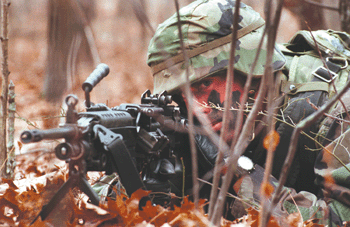
| 
|

| 
|

While Tet raged, another drama was being played out at Khe Sanh. For 77 days the 26th Marines, commanded by Colonel David E. Lownds, held the embattled base against intense pressure by the North Vietnamese, who hurled as many as 1,000 shells a day into the Marine position. President Johnson became so concerned over the siege that he had an exact model of the Khe Sanh base built to monitor to situation on the ground. But Marine tenacity and American air power inflicted grievous losses upon the enemy. On 6 April, the Army's 1st Cavalry Division broke the siege. 1968 marked a turning point for the war in Vietnam. While the enemy had been defeated on the battlefield, American public opinion turned against the war. Television images of the fighting in Hue and Khe Sanh, and even in U.S. Embassy in Saigon eroded public support for the war. After three years of fighting, the enemy still appeared far from beaten. For many Americans thoughts turned from escalation to winding down war in Vietnam.
From the outset the new President, Richard M. Nixon, committed his administration to reducing the level of U.S. forces in Vietnam. For the Marine Corps this meant a gradual reduction of forces in Vietnam. Incrementally, the Marine Corps began to redeploying their units and by the end of the year, the entire 3d Marine Division had returned to Okinawa. As planning continued on reducing forces levels in Vietnam Marines continued to engage the enemy throughout I Corps. Colonel Robert H. Barrow's 9th Marines began OPERATION DEWEY CANYON, perhaps the most successful high-mobility regimental-sized action of the war. Over two months the Marines operated in the A Shau/Da Krong valleys. By 18 March, the enemy base area had been cleared out killing more than 1600 enemy. The Marine air-ground team proved it worth in greatly reducing enemy 122 mm rocket fire into Da Nang. Marine infantry, transported by helicopters, cleared out enemy positions in the rugged "Happy Valley and "Charlie Ridges areas, all supported by effective Marine fixed wing aircraft.
Throughout 1970 U.S. Marine forces continued to withdraw from Vietnam. The new policy emanating from Washington was "Vietnamization." With U.S. airpower and advisors, the ground war was increasingly turned over to the South Vietnamese. While the invasion of Cambodia was the major military undertaking of 1970, only a limited number of Marine aviation assets were involved. Marines still conducted aggressive campaigns against the enemy, most notably Colonel Edmund G. Derning 7th Marines participation in OPERATION PICKENS FOREST and Colonel Paul X. Kelley's 1st Marines actions near Da Nang. But by the end of 1970 more Marines were leaving than arriving as replacements. On 14 April 1971 II MAF redeployed to Okinawa and two months later, the last ground troops, the 13000 men of the 3d Marine Amphibious Brigade, flew out from Da Nang. Although Marine combat units were no longer in Vietnam, Marine advisors remained to assist the South Vietnamese. During the North Vietnamese 1972 "Easter Offensive," Marine Advisors played a pivotal role in repelling the Communist attacks. Captain John W. Ripley, Captain Ray L. Smith, and Captain Lawrence H. Livingston each won the Navy Cross for their heroic contributions in stopping the enemy advances. Following the failure of the Communist's "Easter Offensive" and an intensive bombing campaign of North Vietnam, a peace treaty was finally signed in Paris on 27 January 1973. The U.S. agreed to withdraw all its forces from South Vietnam. The North in turn returned all the U.S. Prisoners of War--including twenty-six Marines. Unfortunately peace was short lived in Vietnam and in 1974 fighting resumed in both Cambodia and South Vietnam.
By the Spring of 1975, the situation became desperate for the U.S. backed governments in both Phnom Penh and Saigon. On 12 April, the 31st MAU, commanded by Colonel John F. Roche, executed a non-combatant evacuation, OPERATION EAGLE PULL, the abandonment of the U.S. embassy in Phnom Penh prior to the city's capitulation to Communist Khemer Rouge forces. Three weeks later, Marines were called upon to evacuate another embassy, this time in Saigon. Marines of the 9th MAB successfully executed OPERATION FREQUENT WIND which safely removed hundreds of Americans and Vietnamese civilians prior to the fall of South Vietnam. No sooner had the Marines evacuated the embassies than they were order by President Gerald R. Ford to rescue the Crew of the U.S.S. Mayaguez which had been taken by the Khymer Rouge. On 15 May a Marine Task Force under the command of Colonel John M. Johnson safely recovered the Mayaguez and her crew, but with high losses. America's longest war was costly to the U.S. Marine Corps. From 1965-1975 nearly 500,000 Marines served in South East Asia. Of these nearly 13,000 were killed and 88,000 wounded, nearly a third of all American causalities sustained during the war.
| Sidebar Site Navigator | Full Screen | Home | Back | Next |